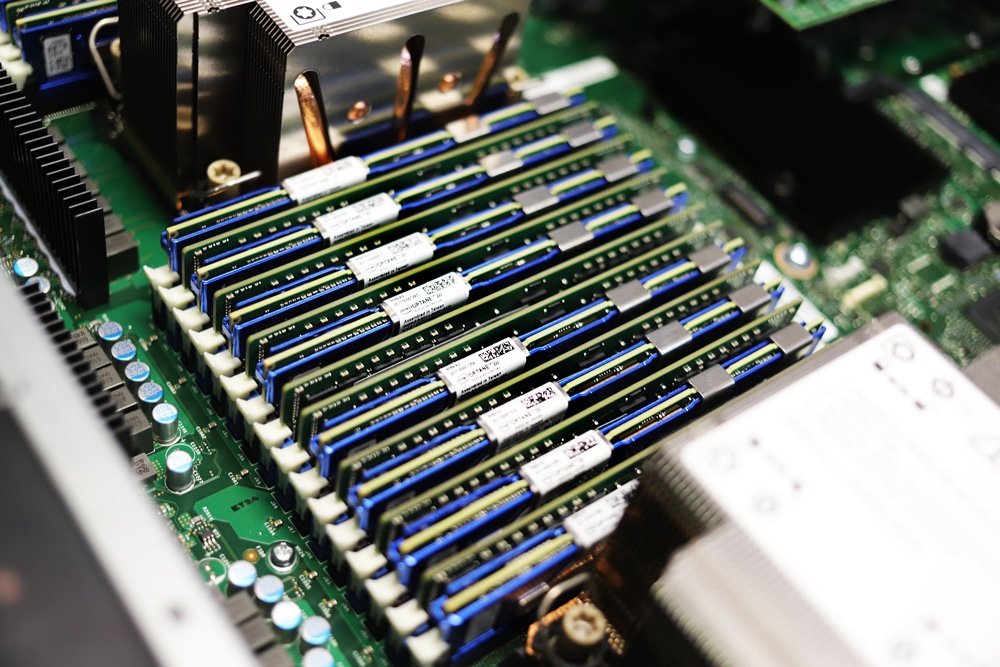As companies continue migrating their data center functions to cloud providers like Amazon Web Services (AWS), Microsoft Azure, Oracle Cloud, and Google Cloud, they find some of those non-fault tolerant applications are costing more than anticipated. The use of temporary, idle cloud inventory is proving problematic.
As companies continue migrating their data center functions to cloud providers like Amazon Web Services (AWS), Microsoft Azure, Oracle Cloud, and Google Cloud, they find some of those non-fault tolerant applications are costing more than anticipated. The use of temporary, idle cloud inventory is proving problematic.
AWS refers to this as a Spot Instance. Azure calls it Low-Priority VM, and Google positions it as Google Cloud Preemptible VM. These resources are temporary and can be revoked with short notice. If a company uses these resources and the instance is pulled before other resources are made available, that data is removed.
There is a solution on the horizon. MemVerge, a developer of memory-centric and multi-cloud solutions, unveiled Big Memory Cloud technology during Cloud Field Day, addressing what to do with those stateful, non-fault-tolerant, and mobility services that need to be added to cloud services. The first cloud service designed with the Big Memory Cloud architecture will be available in public clouds beginning in the first quarter of 2022.
Not All Apps Are Designed for the Cloud
Most traditional apps and an estimated 50% of cloud-native apps are stateful. That means these apps depend on critical data that are either in memory or in persistent storage. When an interruption occurs, e.g., due to a hardware or software failure, critical data is lost, and these apps cannot recover gracefully. These failures can cause loss of valuable data, progress resulting in a restart and downtime.
The inability to handle interruptions means critical apps are unable to take advantage of the following cloud benefits:
- Spot instances – Thousands of stateful, non-fault-tolerant, long-running apps are unable to recover from Spot terminations that occur on short notice, causing companies to reconsider migrating those apps to the cloud. Dedicated resources can be expensive, especially when rarely needed.
- Cloud bursting – On-prem apps are often the subject of a random surge of activity. Interrupting these apps can be time-consuming and complicated. Bursting to the cloud is an option, but cloud resources must be configured, typically a manual process.
- Multi-cloud mobility – Many enterprises are embracing a multi-cloud architecture to avoid lock-in by any cloud service provider. Interruptions will still be lengthy, and configuring cloud services is a complicated manual process, especially between cloud providers.
MemVerge Big Memory Cloud technology promises to enable graceful recovery and mobility for stateful cloud workloads by working in conjunction with cloud automation solutions.
Introducing MemVerge Big Memory Cloud Technology
MemVerge develops Big Memory Computing technology capable of encapsulating stateful apps, including their memory states, into AppCapsules. These AppCapsules can now be used in cloud fault tolerance services to deliver instant recovery and in-cloud mobility services for cloud bursting and cloud-to-cloud migrations.
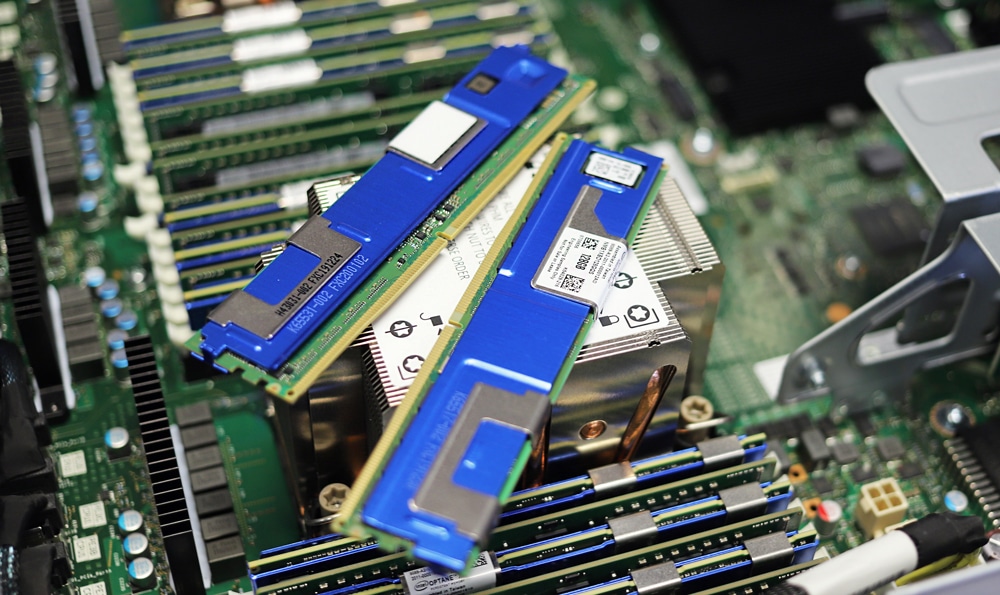
MemVerge has been surveying the landscape of persistent memory and developed software to let PMem hit its potential versus leveraging it as a cache, speed tier, or memory expander. The company uses what it calls Big Memory computing to transform DRAM-only environments into lower costs and more importantly, higher-density memory environments that leverage both DRAM and Intel PMem. It does this by virtualizing the two into a pool of software-defined memory that also delivers software-defined services. On top of the above, the software offers an abstraction layer that allows all applications in a data center to benefit from new types of memory, memory interconnects, processors, and memory allocators to address modern and emerging applications and workloads.
Back in September of last year, MemVerge released the general availability of its Memory Machine. The software is offered in two flavors: Standard Version that virtualizes byte-addressable DRAM and PMem memory speeding apps and lowering costs but doesn’t enable persistence; and AdvancedVersion which is everything above with persistence enabled, as well as enterprise-class memory services that are based on ZeroIO in-memory snapshots.
ZeroIO in-memory snapshots, as the name implies, allows for snapshots of DRAM and PMem with zeroIO to storage. This makes DRAM, which is normally volatile and low-availability, into a high-availability tier. ZeroIO snapshots also allow for what is called time travel, allowing roll back to previous snapshots. There is an AutoSave feature that rolls apps back to the previous snapshot if there is a crash. The snapshots allow for the production of Thin Clones without using more memory resources. And the snapshots can be migrated to other servers and used to create a new app instance.
MemVerge Memory Machine Management
MemVerge Memory Machine has a fairly slick-looking GUI. The global dashboard shows elements we’ve come to expect in storage, the differences, in this case, are that DRAM and PMem are the main elements monitored and usage can easily be seen here. Across the top are tabs for hosts, app instances, snapshots, and alerts.
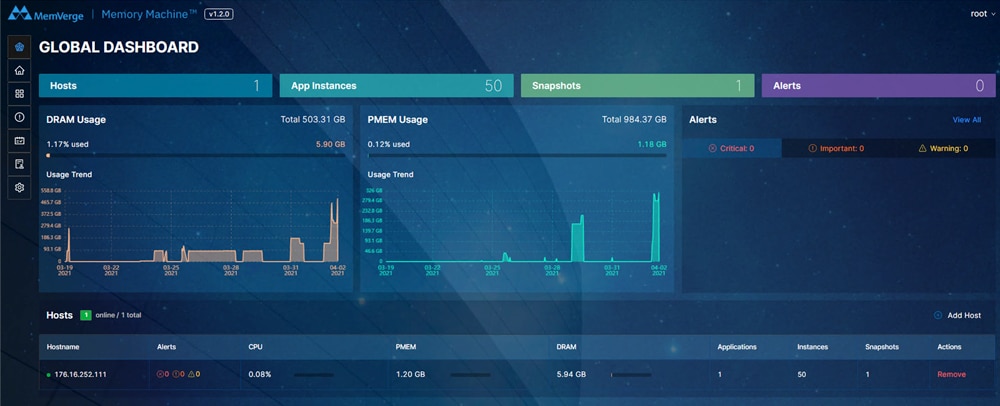
Clicking on the home button on the left brings up basic info on the system (IP address, OS, Kernal version, CPU) as well as a deep dive into Memory and PMem usage and performance.
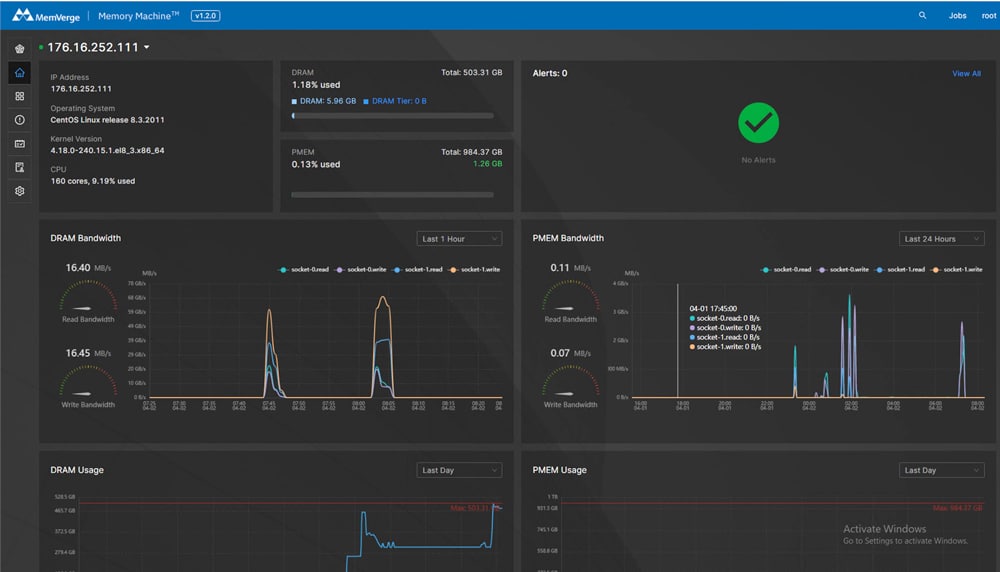
Once a workload is captured in a Memory Machine AppCapsule, it can be loaded, replicated, recovered, and transported at the speed of memory, blending the best of both worlds by enabling DRAM performance with large capacity and persistence. These new cloud services are delivered through Memory Machine Cloud Edition software. We reviewed MemVerge Memory Machine in January 2021 then again with the PMem 200 Series in April 2021.
Long-running apps can be on-ramped to low-cost Spot instances without fear of unexpected instance terminations; apps can burst from on-prem to the cloud at the speed of memory, and big memory workloads can migrate seamlessly to another cloud with automated cloud service configuration.
MemVerge Big Memory Cloud Technology How it Works
- AppCapsules are constructed by capturing all application data necessary for restarting this app from that point in time, without modification to the application.
- Fault-tolerance and mobility services are integrated with cloud service schedulers and cloud-native app orchestration platforms
- The fault-tolerance service can protect a running stateful application on any type of compute instance, including Spot instances
- The mobility service can move a running, stateful application from any instance to any instance.
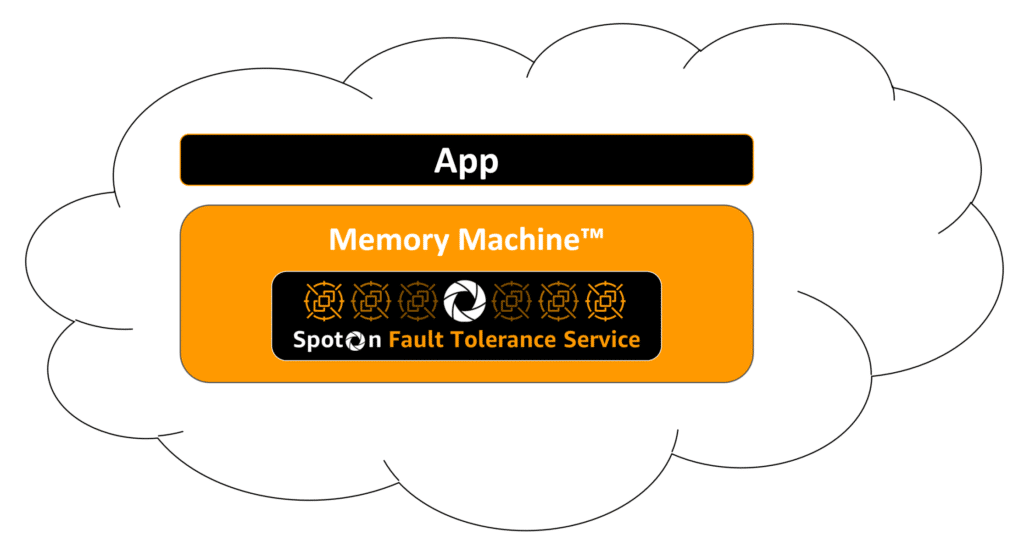
MemVerge is offering early access to SpotOn for AWS. If you have non-fault-tolerant or long-running workloads and deploying on AWS, you can sign up for a free 6-month license to Memory Machine. If interested, you can get in touch here.
Conclusion
MemVerge Big Memory Cloud has the potential to add stateful, non-fault-tolerant applications to an organization’s cloud infrastructure realizing cloud agility and flexibility. Stateful apps rely on data that is resident in memory or persistent storage. In the event of a failure, data can be lost and recovery is less than graceful. Big Memory Cloud could provide that instant recovery to those services.
The release date is Q1 2022, so StorageReview could not test this technology in our lab. However, the demonstrations have been impressive. This technology could be a game-changer for organizations building a hybrid cloud solution for critical apps. Having the ability to utilize low-cost Spot instances will give confidence to implementing a multi-cloud architecture.
Another MemVerge offering is Memory Machine aimed at combining the performance of memory with the persistence of PMem, typically used as a cache to accelerate storage. While this is a boon in many instances for storage, in-memory applications need memory performance, not a cache. MemVerge virtualizes both DRAM and PMem into pools of software-defined memory with software-defined services. Memory Machine turns DRAM into a high-availability tier with the use of zeroIO in-memory snapshots. ZeroIO allows for the creation of Thin Clones without taxing memory resources.
Intel’s PMem is a supremely interesting technology that’s been somewhat slow to adoption because of limited ways to easily adopt and properly leverage the modules. With MemVerge, organizations can take advantage of what PMem has to offer, in a solution that was built specifically with this technology in mind. For those with applications that can benefit from the large and resilient memory footprint PMem offers, MemVerge is definitely worth evaluating.
Engage with StorageReview
Newsletter | YouTube | Podcast iTunes/Spotify | Instagram | Twitter | Facebook | TikTok | RSS Feed

